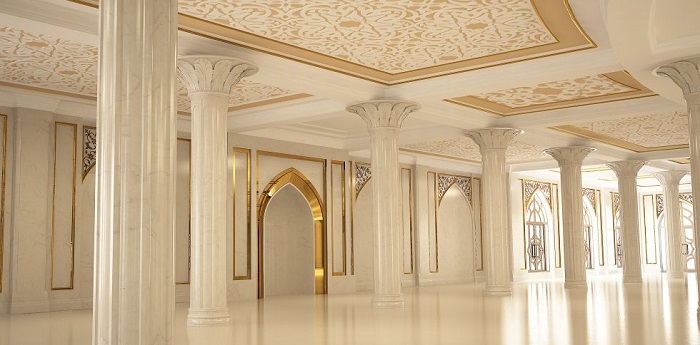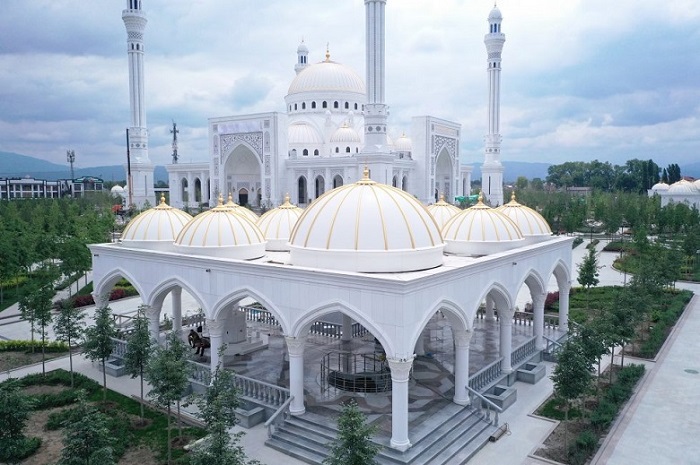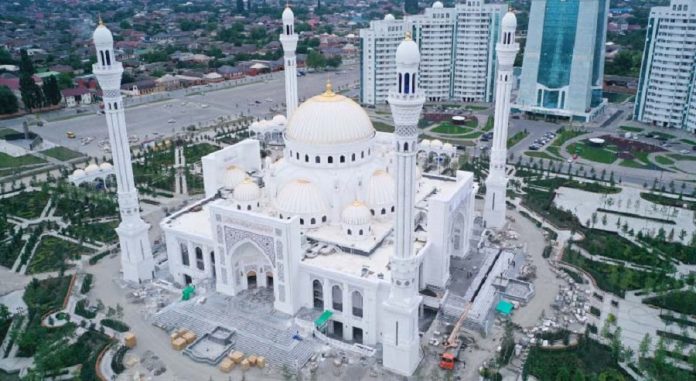With its unprecedented size and beauty, the mosque in the city of Shali in the Chechen Republic of Russia has an awe-inspiring presence. It is considered to be one of the largest mosques in Europe, with a capacity for approximately 20,000 worshippers. The massive structure features Thassos White marble throughout its exterior and interior design, which exhibits shimmering effects and purity—further contributing to its stunning appearance.
“The mosque is reflecting the aesthetic of the Uzbek architecture and rhythm, which is very popular and has been used not only in mosques, but also in governmental buildings,” said the team at FHL Kiriakidis Group in Drama, Greece, the stone producer, fabricator, and installer for the project. “It has clear lines and elements which are perfectly suitable to be combined with a fresh approach and contemporary forms. The architect, who was chosen by the contractor, is an Uzbek himself, with a lot of experience in the field.”
FHL Kiriakidis is accustomed to working on projects of this magnitude, which is why they were chosen for this job. “For us, who were appointed to realize the design in white marble and to install everything, the project appeared big, but at the same time, we are already very experienced in structures of this size,” said the company. “We had the wonderful opportunity to have provided all of the white marble cladding for the Grand Mosque of Abu Dhabi (Shaik Zayed Bin Sultan Mosque), as well as many governmental buildings in Tashkent, Uzbekistan, such as the Conference Hall (Palace of International Forums), the National Parliament, and the National Library. So the delicate handling in production, shipping, and application of massive marble pieces was not new to us, which for sure was one of the criteria to choose our company for this job.”
 A Striking Design
A Striking Design
The architect was drawn to Thassos White marble for its color and popularity. “It has a unique sparkling whiteness,” said the FHL Kiriakidis team. “Under the sunlight, it seems almost that it is made of myriad diamond-like crystals. Thassos marble is still a very popular building material today, providing sheer luxury wherever it is placed. The color white is furthermore a highly symbolic color and synonymous with virtues like purity, new beginnings, and honesty.”
The company explains that marble is an “eternal building material, a fact that is proven through the history of mankind. Greece, especially, has one of the oldest cultures and plenty of heritage with monumental buildings made out of white marble, and particularly Thassos marble, so naturally we consider that sustainability of natural stone played a massive role during the decision process.”
The Shali mosque is designed in a traditional Uzbek rhythm design, with many spindles and columns. The pure white architecture is accented with vibrant pops of color and decorative elements. A palette of natural stones were incorporated into the inlay designs, including Blue Bahia, Baltic Brown, Mary Gold, and Tunas Green granite; Indian Green, Giallo Reale, and Rosso Alicante marble, and K21 onyx.
The team at FHL Kiriakidis explained that Uzbek architecture flourished during the Middle Ages as a result of being a central link in the 11,000-kilometer-long Silk Road. “Colorful mosaics, religious symbols, and abstract geometrical patterns characterize it. The colorful inlays we created from colored marble and granite emphasize very beautifully the all-over whiteness of the entire mosque—giving a playful counterpart to it.”
 Producing the Marble
Producing the Marble
In total, FHL Kiriakidis processed approximately 36,000 tons of Thassos White marble, including many elaborate artifacts. “The marble pieces were very large and heavy,” they shared. “Every marble piece was produced in our factory in Drama, Greece. It had to be dry laid, inspected, packed properly in containers, transported by road to the port of Thessaloniki, Greece, and shipped via vessels and trucks to the final destination in Shali town in the Chechen Republic.”
“Our group’s subcontractor took over the entire installation job, as we have worked on a lot of projects together,” said FHL Kiriakidis. “We had to work in complete unison together, with a lot of onsite visits from our Greek design team.”
Work on the Shali mosque began in 2016 and the project was completed in July 2019. “We got a lot of positive feedback and feel extremely honored to have won a 2019 Pinnacle Award of Excellence in the category Architectural Carving/Lettering/Sculpture [from the Natural Stone Institute] for this beautiful project,” said FHL Kiriakidis.
Source: usenaturalstone.org










































